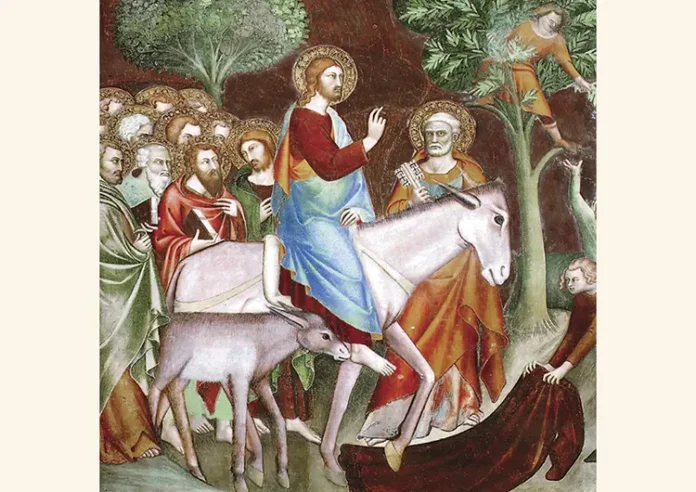Palm Sunday of the Lord’s Passion
Palm Sunday marks the beginning of Holy Week, a period of deep reflection and meaning, which will culminate in the most important feast of the liturgical year: Easter, the Resurrection. The passage from St. Luke’s Gospel (Lk 19:28-40) chosen for this day’s procession recounts Our Lord’s triumphal entry into Jerusalem, an event full of symbolism.
The image of Jesus riding on a colt is often interpreted as a sign of His humility. However, an in-depth analysis reveals in it a more complex and rich message about His kingship, which He Himself will proclaim before Pilate: “You say that I am a King!” (Jn 18:37).
In ancient times, the right of requisition was recognized, which consisted in the royal prerogative to demand any good from subjects. By ordering His disciples to bring a colt, Jesus asserted this right:
“And if anyone should ask you, ‘Why are you untying it?’ you will answer, ‘The Master has need of it’” (Lk 19:31).
In addition, the Evangelist notes that the disciples “helped Jesus to mount” (Lk 19:35) the colt. This phrase echoes the words used by David when he ordered his son to be crowned: “Mount my son Solomon upon my own mule, and escort him down to Gihon. There, Zadok the priest and Nathan the prophet shall anoint him king over Israel” (1 Kgs 1:33-34).
The crowds accompanying Our Lord, immediately understanding these evocations, spread their cloaks along the way – a gesture of honour, royal recognition and submission – just as Elisha’s servants did when they anointed Jehu as ruler, opening their cloaks on the ground in acceptance of his authority (cf. 2 Kg 9:13). This act, together with the shouts of “Blessed is the King who comes in the name of the Lord” (Lk 19:38), proclaimed Jesus as the awaited messianic King.
Thus acclaimed on His entry into Jerusalem, the Redeemer nevertheless demonstrates a unique royalty, distinct from worldly standards of authority and dominion. This is a King who, paradoxically, humbles Himself to the point of death in order to free His subjects from sin and reconcile them with God: as we see in this day’s proclamation of the Passion, He has thorns as His crown, the Cross as His throne and unconditional love as His sceptre. Our Lord does not seek power for Himself, but uses it to serve and love, revealing the true face of divine royalty: a love that gives itself and sacrifices itself for the salvation of all.
Let us follow the example of Our Lord, the King who make Himself a Servant, and learn from Him to love and serve with humble generosity. During this Holy Week, may we give sincere proof of our devotion through our intention to live according to God’s Law, so that we can celebrate Easter with a renewed heart full of hope. ◊


